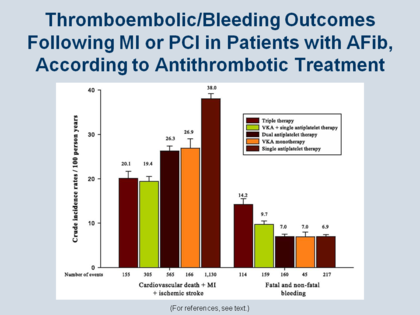William French, MD - Anticoagulation: Special Populations - Figure 22
Bleeding Following MI or PCI
This Figure illustrates the thrombotic and bleeding outcomes following a myocardial infarction or PCI in patients with AFib according to the type of antithrombotic treatment regimen (triple therapy, VKA [vitamin K antagonist], dual antiplatelet therapy, etc.). [134] On the left side of the Figure it can be seen that the lowest incidence of thromboembolic events is in the triple therapy arm. This correlates with the data the right side of the Figure, which shows that the fatal and non-fatal bleeding risk is increased in the patients with triple therapy versus any other combinations. Thus triple therapy is associated with lower rates of cardiovascular death, myocardial infarction (MI), and ischemic stroke, but at the same time triple therapy increases the risk that a patient may have a fatal or non-fatal bleed. For physicians, this Figure simply illustrates a real clinical dilemma that is very much a part of managing these patients.
French WJ. Am J Med 2013; 126: 00-00.

